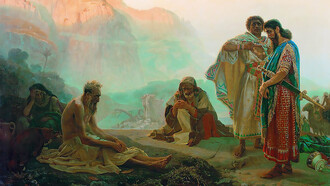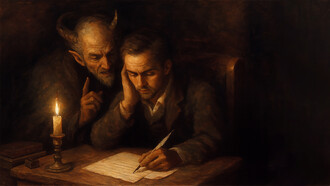Stories of adultery, betrayal, deceit, and a voracious appetite are at the heart of the plot of Le Roman de Renard, a series of poems written in prose during the Middle Ages, in which a devious and elusive fox is the protagonist.
Renard, the fox, is one of the oldest and most interesting characters incarnated in the skin of an animal, an antihero heir not only of the fabulous tales of Phaedrus and Aesop but also of the oriental bestiaries and popular tradition; a celebrity who represented hypocrisy, deceit, lust, and even the devil. Renard, with his extensive geographical and plastic diffusion, was a vehicle for biting satire and anticlerical criticism.
He is a figure whose literary and graphic characteristics make him a candidate to be considered the great-great-grandfather of the “animal strips”.
Le Roman de Renard is an animal epic, a series of poems written throughout the High and Late Middle Ages, narrating the adventures and misdeeds of Renard, the Fox, in the context of the struggle between the bourgeoisie and feudalism and clerical contestation. Renard's adventures, which some say, inaugurate the zooepic genre, take place in an imaginary animal kingdom, with a king, counselors, secretaries, guards, friars, executioners, and informers, all beasts.
The first appearance of “The Fox Reinardus”, so-called in Latin, dates back to 1150, in a poem entitled “Ysengrimus”; the author was the Flemish cleric Nivard or Nivardus. That is the oldest literary source in which the fox was not the main character, but the one who would later become his main antagonist: the wolf Ysengrin.
Around 1175, Reinardus reappears as the fox Renard, the protagonist of a series of short stories written in prose, satirical-parodic adventures, heirs of the classical Western fabulous tradition. We remember, for example, very famous tales that populated our children's imagination from a very early age: The Fox and the Grapes, The Fox and the Stork, The Fox and the Raven, The Fox and the Eagle, to mention just a few.
The most notable author of these adventures was the Frenchman Pierre de Saint-Cloud, to whom is attributed the protagonist's reappearance of Renard and all the dramatic animalistic ecosystem that surrounds him. Saint-Cloud leaves unresolved, however, Renard's conflict with his main antagonist, Ysengrin, the Wolf. This gave rise to the appearance of a sequel of narratives by various authors, called Branches, which, throughout the late Middle Ages, exhibited their exploits and excesses.
At this time Renard transformed and went from being the interpreter of jocular genre scenes to personifying sin, hypocrisy, evil, and the antichrist.
The Physiologus, a Greek manuscript written between the 2nd and 4th centuries, describing animals and their supposed moral endowments, was the predecessor of the medieval bestiaries, where the fox is already described as a cunning and crafty animal since it deceives its prey by “playing dead”. In the Middle Ages, the animals that attacked farms and wiped out vineyards could not be very friendly, and since the fox was evil, perfidious, vile, and rogue, why not? It was also adulterous, lustful, licentious, and obscene. Such impudent behavior caused him to be banished in later centuries, from capitals and temples.
Ysengrin the wolf, Renard's eternal enemy; Hersent, the adulterous she-wolf; Chantecler, the cock protecting the henhouse; the lion king Noble and Fière, the lioness wife, in whom one can guess a certain romance with Renard, are, among many other beasts, the protagonists of these “soap operas”.
Among the most famous episodes, which were an obvious parodic reference to the clerical and courtly usages of his time, is the work of Renard le Contrefait; in this, the fox poses as a great preacher whose virtuosity consists in lulling even the most devout parishioner to sleep; Renard proposes to Chantecler to submit to the test and, while the latter closes his eyes, he captures him by the neck. In another poem (Branche X, 1185), Renard manages to eliminate his enemies by telling Noble, the king, that to be cured he needs the skin of a wolf and the antlers of a stag; the monarch's improvement, falsely attributed to the fox's advice, earns him a promotion as royal advisor.
Renard is the star of a vast literary and iconographic production spread throughout Europe under different names during the Middle Ages (Reinaert, Rainardo, Reinhart, Renart). Pulpits, mosaics, stained glass windows, friezes, palace halls, and manuscripts show scenes from Le Roman de Renard. The fox is a friar, preacher, musician, knight, prisoner, pilgrim, and much more. As time goes by, the character assumes more defined moral traits; in each characterization, one can guess the intentions of political criticism.
Representations of Renard are abundant during the thirteenth century and throughout the fourteenth century, but it is in the fifteenth century when those with satirical content become evident, for example, in the stained glass windows of York Cathedral, a fox can be seen preaching to an audience of ducks from a pulpit and seems to allude sarcastically to the relationship between priests and faithful.
The character of Renard was not only used to criticize entire clerical guilds such as the mendicant orders, but also to talk about legendary events and specific individuals; for example, it seems to be an analogy between the Branche de Renard le Empereur and the episode in which Mordred usurps the throne from King Arthur.
Renard became a vehicle for political struggle, a stereotypical character for all occasions. The fox was prolifically used by nobles, clerics, and literati in their struggle to preserve their privileges, but a popular aspect can also be distinguished in the oral narration among the pilgrims who toured the medieval temples.
There is no concordance between literature and iconography about Renard's fate; luck did not always smile at him. It is mainly in the non-literary narratives that he is seen heading to the scaffold, after a summary trial. His funeral was widely reproduced artistically, with the rooster Chantecler presiding over the cortege on the way to the cemetery. However, Renard was resurrected and his resurgence is not only physical but symbolic. In Renard's Le Couronnement, written sometime between 1260 and 1273, the fox seizes the throne and his verses imply that a period of immorality and hypocrisy has dawned on earth, an era that, judging by the facts, continues.
Such is the story of Renard, the fox, which over the centuries has undergone a process of decaffeination and desexualization until it has become a children's story, as have so many other originally terrible and bloody tales, such as Little Red Riding Hood, Hansel and Gretel or Pinocchio.
Renard the fox, is an ancient character buried under the deafening multimedia variety, whose echoes, however, still resonate in the unconscious of these generations and in the “animal strips”.















